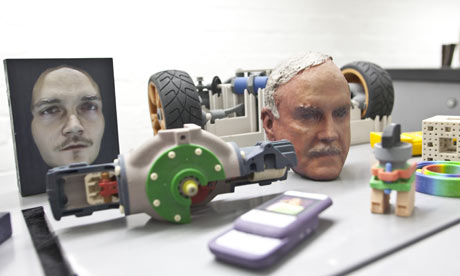[div class=attrib]From The New York Times:[end-div]
 RETHINKING THE WEB Jaron Lanier, pictured here in 1999, was an early proponent of the Internet’s open culture. His new book examines the downsides.
RETHINKING THE WEB Jaron Lanier, pictured here in 1999, was an early proponent of the Internet’s open culture. His new book examines the downsides.
In the 1990s, Jaron Lanier was one of the digital pioneers hailing the wonderful possibilities that would be realized once the Internet allowed musicians, artists, scientists and engineers around the world to instantly share their work. Now, like a lot of us, he is having second thoughts.
Mr. Lanier, a musician and avant-garde computer scientist — he popularized the term “virtual reality” — wonders if the Web’s structure and ideology are fostering nasty group dynamics and mediocre collaborations. His new book, “You Are Not a Gadget,” is a manifesto against “hive thinking” and “digital Maoism,” by which he means the glorification of open-source software, free information and collective work at the expense of individual creativity.
He blames the Web’s tradition of “drive-by anonymity” for fostering vicious pack behavior on blogs, forums and social networks. He acknowledges the examples of generous collaboration, like Wikipedia, but argues that the mantras of “open culture” and “information wants to be free” have produced a destructive new social contract.
“The basic idea of this contract,” he writes, “is that authors, journalists, musicians and artists are encouraged to treat the fruits of their intellects and imaginations as fragments to be given without pay to the hive mind. Reciprocity takes the form of self-promotion. Culture is to become precisely nothing but advertising.”
I find his critique intriguing, partly because Mr. Lanier isn’t your ordinary Luddite crank, and partly because I’ve felt the same kind of disappointment with the Web. In the 1990s, when I was writing paeans to the dawning spirit of digital collaboration, it didn’t occur to me that the Web’s “gift culture,” as anthropologists called it, could turn into a mandatory potlatch for so many professions — including my own.
So I have selfish reasons for appreciating Mr. Lanier’s complaints about masses of “digital peasants” being forced to provide free material to a few “lords of the clouds” like Google and YouTube. But I’m not sure Mr. Lanier has correctly diagnosed the causes of our discontent, particularly when he blames software design for leading to what he calls exploitative monopolies on the Web like Google.
He argues that old — and bad — digital systems tend to get locked in place because it’s too difficult and expensive for everyone to switch to a new one. That basic problem, known to economists as lock-in, has long been blamed for stifling the rise of superior technologies like the Dvorak typewriter keyboard and Betamax videotapes, and for perpetuating duds like the Windows operating system.
It can sound plausible enough in theory — particularly if your Windows computer has just crashed. In practice, though, better products win out, according to the economists Stan Liebowitz and Stephen Margolis. After reviewing battles like Dvorak-qwerty and Betamax-VHS, they concluded that consumers had good reasons for preferring qwerty keyboards and VHS tapes, and that sellers of superior technologies generally don’t get locked out. “Although software is often brought up as locking in people,” Dr. Liebowitz told me, “we have made a careful examination of that issue and find that the winning products are almost always the ones thought to be better by reviewers.” When a better new product appears, he said, the challenger can take over the software market relatively quickly by comparison with other industries.
Dr. Liebowitz, a professor at the University of Texas at Dallas, said the problem on the Web today has less to do with monopolies or software design than with intellectual piracy, which he has also studied extensively. In fact, Dr. Liebowitz used to be a favorite of the “information-wants-to-be-free” faction.
In the 1980s he asserted that photocopying actually helped copyright owners by exposing more people to their work, and he later reported that audio and video taping technologies offered large benefits to consumers without causing much harm to copyright owners in Hollywood and the music and television industries.
But when Napster and other music-sharing Web sites started becoming popular, Dr. Liebowitz correctly predicted that the music industry would be seriously hurt because it was so cheap and easy to make perfect copies and distribute them. Today he sees similar harm to other industries like publishing and television (and he is serving as a paid adviser to Viacom in its lawsuit seeking damages from Google for allowing Viacom’s videos to be posted on YouTube).
Trying to charge for songs and other digital content is sometimes dismissed as a losing cause because hackers can crack any copy-protection technology. But as Mr. Lanier notes in his book, any lock on a car or a home can be broken, yet few people do so — or condone break-ins.
“An intelligent person feels guilty for downloading music without paying the musician, but they use this free-open-culture ideology to cover it,” Mr. Lanier told me. In the book he disputes the assertion that there’s no harm in copying a digital music file because you haven’t damaged the original file.
“The same thing could be said if you hacked into a bank and just added money to your online account,” he writes. “The problem in each case is not that you stole from a specific person but that you undermined the artificial scarcities that allow the economy to function.”
Mr. Lanier was once an advocate himself for piracy, arguing that his fellow musicians would make up for the lost revenue in other ways. Sure enough, some musicians have done well selling T-shirts and concert tickets, but it is striking how many of the top-grossing acts began in the predigital era, and how much of today’s music is a mash-up of the old.
“It’s as if culture froze just before it became digitally open, and all we can do now is mine the past like salvagers picking over a garbage dump,” Mr. Lanier writes. Or, to use another of his grim metaphors: “Creative people — the new peasants — come to resemble animals converging on shrinking oases of old media in a depleted desert.”
To save those endangered species, Mr. Lanier proposes rethinking the Web’s ideology, revising its software structure and introducing innovations like a universal system of micropayments. (To debate reforms, go to Tierney Lab at nytimes.com/tierneylab.
Dr. Liebowitz suggests a more traditional reform for cyberspace: punishing thieves. The big difference between Web piracy and house burglary, he says, is that the penalties for piracy are tiny and rarely enforced. He expects people to keep pilfering (and rationalizing their thefts) as long as the benefits of piracy greatly exceed the costs.
In theory, public officials could deter piracy by stiffening the penalties, but they’re aware of another crucial distinction between online piracy and house burglary: There are a lot more homeowners than burglars, but there are a lot more consumers of digital content than producers of it.
The result is a problem a bit like trying to stop a mob of looters. When the majority of people feel entitled to someone’s property, who’s going to stand in their way?
[div class=attrib]More from theSource here.[end-div]
 [div class=attrib]From Wired:[end-div]
[div class=attrib]From Wired:[end-div]
 Imagine a world without books; you’d have to commit useful experiences, narratives and data to handwritten form and memory.Imagine a world without the internet and real-time search; you’d have to rely on a trusted expert or a printed dictionary to find answers to your questions. Imagine a world without the written word; you’d have to revert to memory and oral tradition to pass on meaningful life lessons and stories.
Imagine a world without books; you’d have to commit useful experiences, narratives and data to handwritten form and memory.Imagine a world without the internet and real-time search; you’d have to rely on a trusted expert or a printed dictionary to find answers to your questions. Imagine a world without the written word; you’d have to revert to memory and oral tradition to pass on meaningful life lessons and stories.
![John William Waterhouse [Public domain], via Wikimedia Commons](http://upload.wikimedia.org/wikipedia/commons/thumb/6/6b/John_William_Waterhouse_Echo_And_Narcissus.jpg/640px-John_William_Waterhouse_Echo_And_Narcissus.jpg) [div class=attrib]Echo and Narcissus, John William Waterhouse [Public domain], via Wikimedia Commons[end-div]
[div class=attrib]Echo and Narcissus, John William Waterhouse [Public domain], via Wikimedia Commons[end-div]

 [div class=attrib]From ReadWriteWeb:[end-div]
[div class=attrib]From ReadWriteWeb:[end-div] [div class=attrib]From Scientific American:[end-div]
[div class=attrib]From Scientific American:[end-div]

 [div class=attrib]From the Guardian:[end-div]
[div class=attrib]From the Guardian:[end-div]
 [div class=attrib]From The Observer:[end-div]
[div class=attrib]From The Observer:[end-div] [div class=attrib]From The New York Times:[end-div]
[div class=attrib]From The New York Times:[end-div] [div class=attrib]From The Guardian:[end-div]
[div class=attrib]From The Guardian:[end-div] [div class=attrib]More from theSource
[div class=attrib]More from theSource  [div class=attrib]From Discover:[end-div]
[div class=attrib]From Discover:[end-div] RETHINKING THE WEB Jaron Lanier, pictured here in 1999, was an early proponent of the Internet’s open culture. His new book examines the downsides.
RETHINKING THE WEB Jaron Lanier, pictured here in 1999, was an early proponent of the Internet’s open culture. His new book examines the downsides.